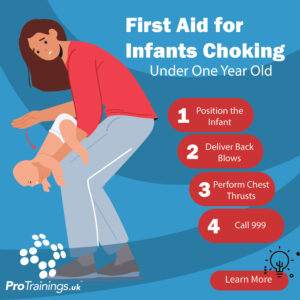First Aid for Choking: How to Save a Life in Seconds
Choking is a life-threatening emergency that can happen to anyone at any time. Knowing how to respond quickly and effectively can make the difference between life and death. This guide will teach you the essential steps for providing first aid to someone who is choking, helping you save a life in seconds.
1. Recognising the Signs of Choking
The first step in providing aid is recognising that someone is choking:
Signs of Severe Choking:
- The person cannot speak, breathe, or cough.
- They may clutch their throat, which is the universal sign for choking.
- The skin, lips, and nails may turn blue (cyanosis) due to lack of oxygen.
- The person may make high-pitched noises or no sound at all.
Signs of Mild Choking:
- The person can still cough and speak.
- They may be able to clear the obstruction by coughing forcefully.
- Encourage them to keep coughing to try to dislodge the object.
2. First Aid for Adults and Children Over One Year Old
If the person is unable to cough, speak, or breathe, immediate action is needed:
Step 1: Ask for Permission
If the person is conscious, ask them if they’re choking and if you can help. If they nod or cannot respond verbally, proceed with first aid.
Step 2: Deliver Back Blows
- Position Yourself: Stand behind the person and slightly to the side. Support their chest with one hand, and lean them forward so that the object blocking their airway can come out of their mouth.
- Deliver Blows: Using the heel of your other hand, give up to five firm back blows between the person’s shoulder blades. Check if the obstruction is cleared after each blow.
Step 3: Perform Abdominal Thrusts (used to be referred to as the Heimlich Manoeuvre)
- Position Your Hands: Stand behind the person. Place one foot between their feet for stability. Make a fist with one hand and place it just above the person’s navel (belly button) and below the ribcage. Grasp your fist with your other hand.
- Deliver Thrusts: Pull sharply inwards and upwards, as if you’re trying to lift the person off their feet. Perform up to five abdominal thrusts.
- Repeat: Alternate between five back blows and five abdominal thrusts until the object is dislodged or the person becomes unresponsive.
Step 4: Call 999
If the person is still choking after trying back blows and abdominal thrusts, or if they become unresponsive, call 999 immediately. Continue with the first aid until emergency services arrive.
3. First Aid for Infants Under One Year Old
For infants, the procedure is slightly different due to their smaller size and fragility:
Step 1: Position the Infant
- Hold the Infant: Lay the baby face down along your forearm, supporting their head and neck with your hand. Keep the infant’s head lower than their chest.
- Support the Head: Ensure you’re supporting the baby’s head by placing your hand under their jaw.
Step 2: Deliver Back Blows
- Give Back Blows: Using the heel of your hand, deliver up to five gentle but firm back blows between the infant’s shoulder blades.
Step 3: Perform Chest Thrusts
- Position the Infant: Turn the infant over onto their back while supporting their head. Use your forearm to support their body, keeping their head lower than the chest.
- Deliver Thrusts: Place two fingers on the centre of the infant’s chest, just below the nipple line. Give up to five chest thrusts, pressing down about 1.5 inches (4 cm).
- Repeat: Alternate between five back blows and five chest thrusts until the object is expelled or the infant becomes unresponsive.
Step 4: Call 999
If the object is not dislodged or the infant becomes unresponsive, call 999 immediately and continue with the first aid until help arrives.
4. What to Do If the Person Becomes Unresponsive
If the person becomes unresponsive, it’s essential to start CPR immediately:
Step 1: Call for Help
Ensure someone has called 999 or do so yourself if you are alone.
Step 2: Start CPR
- Perform Chest Compressions: Begin CPR with chest compressions. If you are trained, give 30 chest compressions followed by 2 rescue breaths. If not, continue with hands-only CPR by performing chest compressions at a rate of 100-120 per minute.
- Check the Airway: Before giving breaths, check the mouth for the object causing the blockage. Remove it if visible but do not perform a blind finger sweep.
Step 3: Continue CPR
Continue CPR until the person shows signs of life, such as breathing or movement, or until emergency medical services take over.
5. Preventing Choking
Prevention is always better than cure. Here are some tips to prevent choking:
- Cut Food Properly: Cut food into small, manageable pieces, especially for children and the elderly.

- Avoid Distractions: Encourage people to sit down and eat slowly, avoiding talking, laughing, or running while eating.
- Keep Small Objects Out of Reach: Ensure small objects like coins, buttons, and toys are kept away from infants and young children.
- Supervise Meals: Always supervise children during meals and ensure they are chewing their food thoroughly.
- Be Trained: Complete a video online training course or one of our face to face courses to learn what to do if someone chokes and this will training you on many other first aid emergencies.
Conclusion
Choking is a critical emergency that requires immediate action. By knowing how to provide first aid for choking, you can act quickly and effectively to save a life. Familiarise yourself with these techniques, and consider taking a first aid course to gain hands-on experience and confidence in performing these life-saving procedures.
